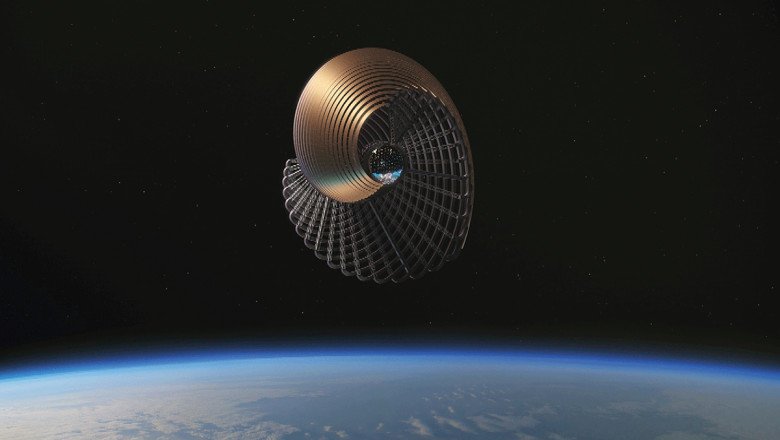
views
Quick Links
SECTIONS
- Business
- Entertainment
- Future of Work
- Health & Wellness
- Lifestyle
- Money
- Personal Development
- Professional Development
- Relationships
- SUCCESS Bestsellers
- Business
- Entertainment
- Future of Work
- Health & Wellness
- Lifestyle
- Money
- Personal Development
- Professional Development
- Relationships
- SUCCESS Bestsellers
JOIN US
- SUCCESS+
- SUCCESS Coaching
- Speakers Bureau
- SUCCESS Events
- SUCCESS Space
- Newsletter
- Daily SMS
- Subscribe
- Shop the SUCCESS Store
- SUCCESS+
- SUCCESS Coaching
- Speakers Bureau
- SUCCESS Events
- SUCCESS Space
- Newsletter
- Daily SMS
- Subscribe
- Shop the SUCCESS Store
GET IN TOUCH
CONNECT
Instagram Facebook Tiktok Linkedin Pinterest X-twitterMORE

Unlock the Latest Knowledge that Can You Help You Achieve More in Life with More Confidence
Print and Digital Options Available
BOOKMARK Share TABLE OF CONTENTS
TABLE OF CONTENTS


Take your vision of the future, multiply it by a few light-years, and you have a glimpse into the possibilities in the mind and career of Ariel Ekblaw. She’s the founding director of the MIT Space Exploration Initiative and co-founder and CEO of Aurelia Institute, a nonprofit education and research center and space architecture research and development lab. Ekblaw, Ph.D., works on multiple projects aimed at expanding humanity’s ability to thrive in space.
And this isn’t part of some far-off, futuristic vision. Some of her concepts are already underway, and others will benefit humanity in the next few years. Think: floating apartments and remote work environments circling our planet; diverse, microbiome-improving food options that are far from the “space food” in the movies; artificial retinas that cure blindness on Earth; and AstroAnt robots that function like tiny cars to diagnose and repair spacecraft.
Her team isn’t looking to leave Earth to visit other planets; they are looking to expand into the closest layer of space. “Earth is the best home humanity will ever have. It’s the only place where our biology co-evolved with the planet, so we are always going to be better suited here,” Ekblaw says.
Learn more about the innovations Ariel Ekblaw and her team are developing.
Retinitis pigmentosa is the leading cause of heritable blindness and affects approximately 100,000 people in the United States and 1.5 million people worldwide. Macular degeneration, the leading form of blindness in patients over 55, affects 10 million in the U.S. and over 50 million worldwide. These stats from LambdaVision co-founder and CEO Nicole Wagner, Ph.D., are what’s driving her to solve the world’s vision issues supported by Ekblaw’s VC fund.
Patients can’t just get a new retina. But in orbit, where gravity restrictions don’t apply, artificial retina scientists apply over 200 layers of a matrix. This process creates an artificial retina. “What’s special about this is that it needs microgravity to happen—it can’t be done on Earth. The reason it can’t be done on Earth is because of sedimentation,” Ekblaw says, referencing a drink, where “stuff sinks down to the bottom.” Those particles would lead to lots of errors in the matrix, with those errors “amplified by every layer.”
“Microgravity gives you this beautiful floating environment, kind of like the womb, where eyes are originally grown,” Ekblaw says. “And it’s the perfect environment.” Those space-built retinas would be a welcome alternative to prosthetics that people have to wear over their eyes currently, Ekblaw says.
Wagner expects the project to be in clinical trials in three to four years. “There is a huge unmet need to help patients blinded by these diseases, and our goal is to [get] the artificial retina into patients in need as soon as possible,” Wagner adds.
TESSERAE: It stands for Tessellated Electromagnetic Space Structures for the Exploration of Reconfigurable, Adaptive Environments. Confused? Just think of a large, transformable floating pavilion that’s “big, beautiful science fiction” but modular, cut into different tiles that can be packed flat into a rocket, Ekblaw says, “like a glorified PEZ dispenser.” She compares them to Legos that could build themselves in space.
“Right now, on the International Space Station, if there’s a micrometeorite impact, and it punctures the space habitat, you have to repair it…. It’s actually very hard to repair,” Ekblaw says. “But the idea with a reconfigurable habitat is that there’s all these different parts. If there’s damage to one, you just pop it off and replace it.”
Even more fun, you can swap out your window that previously had a view of Earth for a docking port where your friends might show up for a party at your building, she says. “It’s meant to be architecture in space that would finally scale access.”
Ekblaw estimates that, perhaps in the next decade, scientists and researchers might head to space, too, instead of just astronauts. Then, tourists might come later, in the 2040s.
Ekblaw’s team is planning its first test in 10 years. And if you ask Ekblaw how expensive a ticket to your remote workplace hangout in space might be, she compares it to probably “slightly fancy commercial aviation.”
In addition to improving Earth, Ekblaw’s vision involves building the future of human culture in space. “We shouldn’t always just take up into space the cultural artifacts from Earth; we should let that also be a domain where we are creating new and novel cultural artifacts for humanity,” she says. Ekblaw points to a Telemetron, a steampunk-inspired object with two percussive elements inside two modules that players can only use while floating.
Designers Sands Fish, Nicole L’Huillier and Thomas Sanchez Lengeling have already played this instrument on a “Zero-G flight,” at the top of which you get around 20 seconds of microgravity. “[Then] they turned that one Telemetron into a zero gravity orchestra—they had a series of other types of instruments that have been designed for the same environment,” she says. “Quirky, wacky, beautiful design.”
She wants to ensure that nonscientists can expand into space. “We need welders. We need plumbers. We need all kinds of tradespeople, so it will be a combination of traditional blue-collar work and white-collar opportunities,” Ekblaw says.
She’s a part of two flights per year, one with Aurelia and one with MIT, with an eye on equity. “We try to do it explicitly with communities that are not as often welcomed into aerospace,” she says, whether it’s due to their industry, like artists and musicians, or because they are from marginalized communities with less access to STEM education, she adds.
So, the next time you are shopping for apartments or your next best remote office, remember that one with a window facing planet Earth from space, no matter your industry, might not be far off.
This article originally appeared in the July/August 2024 Photo courtesy of @aureliainstitute.org
5473 Blair Road, Suite 100
PMB 30053
Dallas, TX 75231
Copyright © 2024 SUCCESS Magazine. All rights reserved.
Unlock the Latest Knowledge that Can You Help You Achieve More in Life with More Confidence
Print and Digital Options Available
Copyright © 2024 SUCCESS Magazine. All rights reserved.
Unlock the Latest Knowledge that Can You Help You Achieve More in Life with More Confidence
Print and Digital Options Available
https://www.success.com/ariel-ekblaw-space-innovation/





















Comments
0 comment